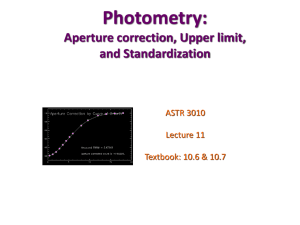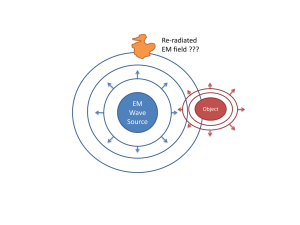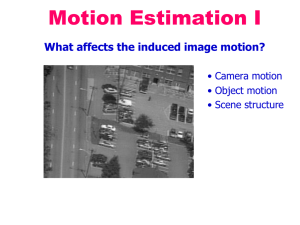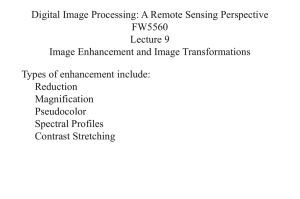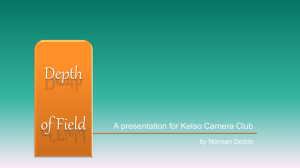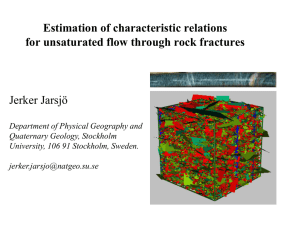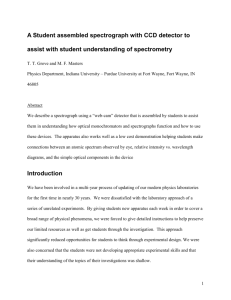Basics of Spectroscopy
advertisement
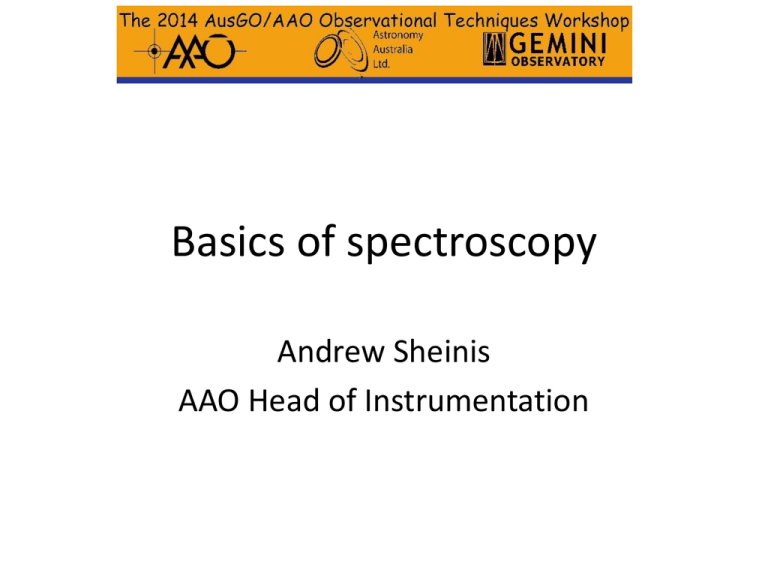
Day 1: Tuesday, 1 April: Chair: Chris Lidman 11:30-12:55: Registration 12:55-13:00: Welcome (Caroline Foster) 13:00-13:30: Introduction to optical and IR facilities (Chris Tinney) Basics of spectroscopy 13:30-14:00: Writing proposals and the TAC process (Sarah Martell) 14:00-14:30: Observing preparation and software tools (Simon O'Toole) 14:30-15:15: Gemini queue demystified, Gemini helpdesk & data archives (Richard McDermid) 15:15-15:45: Afternoon tea Andrew Sheinis AAO Head of Instrumentation Chair: Stuart Ryder 15:45-16:30: Optical and infrared detectors (Kyler Kuehn) 16:30-17:30: An introduction to data reduction (Keith Shortridge) Day 2: Wednesday, 2 April: Chair: Kyler Kuehn 9:00-10:00: Imaging, photometry and filters (Lee Spitler) 10:00-10:30: Morning tea Some questions: • • • • What are the parts of a spectrograph Why are spectrographs so big? What sets the sensitivity? How do I estimate the exposure time? Some questions: • • • • What are the parts of a spectrograph Why are spectrographs so big? What sets the sensitivity? How do I estimate the exposure time? DTel Spectrograph collimator Slit (image) plane Dcoll disperser Dcam camera detector Telescope Anamorphic factor, r = Dcoll/ Dcam Dispersers: Gratings, Grisms and Prisms •Gratings •Reflection gratings •Ruled vs replicated •mosaics •Transmission gratings •holographic •Prisms Glass Dispersion ratio (9500/3500) notes LiF 0.092335 exotic, hard to get F_silica 0.079616 nice, easy to get FK5 0.077572 “ “ BK7Y 0.0737 “ “ LF5 0.043 poor dispersion ratio •Grisms •High dispersion Grating •Low-dispersion prism •Prism deflection angle chosen to pass some central wavelegth straight throughplus a prism Schroeder ch 13 and 14 What causes dispersion • Optical path difference in the interfering beam, • Or • Optical time delay in the interfering beam d W - d1 n Grating equation: n l = d(sin(a ) + sin(b )) Differentiate WRT : dl d cos(b ) = db n - n How do you get a long time delay • • • • Long grating (echelle) High index (immersion grating Big beam All of the above What are Echelles/echellettes? • • • • • • Course, precisely-ruled gratings (few grooves/mm) Used at high-angles= high R; R= tan(b) bis BIG, b = 63 degrees to 78 degrees Used at high orders N=100-600 (echelle) N=10-100 (echellette) Echelles/echellettes important features • High dispersion in compact package • High R-value (high tanb) High throughput • High blaze efficiency over wide wavelength range • Nearly free of polarization effects Echelles/echellettes disadvantages • • • • Hard to manufacture Orders overlap Need order-blocking filters or Cross-dispersion (becomes an advantage with a 2-D detector) Volume Phase Holographic Gratings Examples of VPH grisms with tilted fringes (above, 1a), and fringes at Littrow (below, 1b). Both gratings are 930 l/mm blazed at 600 nm. For reference, the size of the beam, paraxial camera and focal surface are the same. * Hill, Wolf, Tufts, Smith, 2003, SPIE, 4842, Collimators ESI on Keck •Reflective parabola •Off axis, on axis •FOV •Transmissive •Catadioptric •Schmidt RSS on SALT Hermes on AAT Cameras, second to grating in importance •Why? •A is effectively larger for the camera than the collimator. •Dispersed slit is effectively a larger field. Anamorphism and dispersion increase “pupil” size •Most challenging part of the optical system. Slits are big, pixels are small so we are often demagnifying, thus cameras are faster and have a larger A . Cameras •Reflective •Two Mirror correct for spherical and coma •Un-obscured 3-mirror an-astigmat corrects for spherical, coma and astigmatism, (Paul-Baker, Merseinne Schmidt) (i.e Angel, Woolf and Epps, 1982 SPIE, 332, 134A) •Transmissive •Epps cameras •Catadioptric •Schmidt Slits-MOS plates-IFUS • Slits – Separates the stuff you want from the stuff you don’t • Fibers – Allow you to have a spectrograph far from the telescope (why would you want this?) • IFUS – Reformat the filed to be along a slit • Mos – Separates the lots of stuff you want from lots of the stuff you don’t Detectors • • • • • • • Human eye CCD CMOS MCT InGaAs PMT Lots of others Some questions: • • • • What are the parts of a spectrograph Why are spectrographs so big? What sets the sensitivity? How do I estimate the exposure time? Three Spectrographs of similar field and resolution • Why do they look so different? SDSS 2.5M Nasmyth Focus at Keck 10M TMT 30M Thought experiment 1: How Big an aperture do you need to achieve R=100,000 in the diff-limited case on a 10-meter telescope at 1 m? a) b) c) d) 2.5 meters 250 mm 25 mm 2.5 mm DTel Spectrograph collimator disperser camera detector Slit (image) plane Dcoll Telescope Anamorphic factor, r = Dcoll/ Dcam Dcam Fcoll Ftelescope Slit, s Slit-Width resolution product collimator d1 f R= 2tan(q b ) Dtel W grating DColl grating Dtelescope DCam Telescope camera Bingham 1979 detector FCam OPD available for interference in the coherent beam ! Diff-limited f= l Dtel R= d1 l 2tan(q b ) seeing-limited f= l r0 * Not just for Littrow: n*grooves * n = OPD r0 d1 R= 2 tan(q b ) Dtel l •One way to think about this: Spectrograph resolution is NOT a function of the spectrograph or the optics! •R ~ OPD or optical time delay available for interference in the coherent beam (works for prisms and other dispersing elements too) •The job of the telescope/spectrograph/AO system is to create as much OPD as possible then collect that information! Some numbers: Consider collimator diameter for an R2 (tan=2) spectrograph with R=50,000 at =1 micron • 2.5-meter aperture > 150mm Dcol • 10-meter aperture > 0.61-meter Dcol • 30-meter aperture > 1.84-meter Dcol • Diffraction-limited > 12.8-mm Dcol! Some questions: • • • • What are the parts of a spectrograph Why are spectrographs so big? What sets the sensitivity? How do I estimate the exposure time? Thought Experiment: You observe the moon using an eyepiece attached to a 8 meter telescope. What is the relative brightness of the image compared to naked-eye viewing? (or will this blind you?) assume your eye has an 8mm diameter pupil. A) Brightness=(8e3/8)2=1,000,000 times B) Brightness=(8e3/8)=1,000 times C) The same, Brightness is conserved! Spectrograph Speed Speed=# of counts/s/Angstrom I. Slit-limited II. Intermediate III. Image-limited Bowen, I.S., “Spectrographs,” in Astronomical Techniques, ed. by W.A. Hiltner, (U. of Chicago Press, 1962), pp. 34-62. Spectrograph Speed Schroeder 12.2e, Ira Bowen (1962) I. Slit-limited Speed µD ·W 0 Tel II. 2 grating Intermediate Speed µD ·W 1 Tel 1 grating III. Image-limited Speed µD ·W 2 Tel Speed=# of counts/s/Angstrom, W= illuminated grating length 0 grating Surface Brightness • Surface brightness is the energy per unit angle per unit area falling on (or passing through) a surface. • Conserved for Finite size source (subtends a real angle) • Also called – Specific intensity – Brightness, surface brightness – Specific brightness • Units: (Jy sr-1) or (W m-2 Hz-1sr -1) or (erg cm-2 Hz -1) or (m arcsec-2) Surface Brightness Rybicki and Lightman, Radiative Processes in Astrophysics (1979), Ch1 A1 A0 A2 A0 =A1 A2 • Surface brightness is the energy per unit angle per unit area falling on (or passing through) a surface. • Conserved for Finite size source (subtends a real angle) • Also called – Specific intensity – Brightness, surface brightness – Specific brightness • Units: (Jy sr-1) or (W m-2 Hz-1sr -1) or (erg cm-2 Hz -1) or (m arcsec-2) Spectrograph collimator A0 Dtelescope grating A1 Slit (image) plane camera Telescope Energy Collected detector A2 Energy Collected Energy Collected Do not confuse Surface Brightness with Flux Flux is total energy incident on some area dA from a source (resolved or not). Flux is not conserved and falls of as R-2. dE = fu dA du dt dE = fu (4 pR ) du dt = Lu du dt Lu \ fu = 2 (4pR ) 2 Some questions: • • • • What are the parts of a spectrograph Why are spectrographs so big? What sets the sensitivity? How do I estimate the exposure time? S/N for object measured in aperture with radius r: npix=# of pixels in the aperture= πr2 Noise from the dark current in aperture R*t Signal Noise 2ö é ù æ æ ö 2 gain ê R* × t + Rsky × t × npix + çç ( RN ) + ç ÷ ÷÷ × n pix + Dark × t × npix ú è 2 ø ø êë úû è Readnoise in aperture (R* × t) 2 Noise from sky e- in aperture All the noise terms added in quadrature Note: always calculate in e- 1 2 How do I calculate the number of photo electrons/s on my detector? • Resolved source • • – We are measuring surface brightness – E=AI For an extended object in the IR that is easy: You just need the temperature of the source, the system losses (absorption, QE etc), resolution and etendu of a pixel. No telescope aperture or F/#, no slit size, no optical train! For an extended object in the visible: You just need the surface brightness of the source, the system losses (absorption, QE etc), resolution and etendu of a pixel. No telescope aperture or F/#, no slit size, no optical train! • Point source – we are measuring flux – E=Afdt • For an unresolved object, you need the source magnitude, telescope aperture, system losses and resolution. Ex 1: Thermal Imaging R=5000 Pixel size= 10 microns Final focal ratio at detector = F/3 Source temperature=5000K Operating near 2 microns SB from Planck=1,157,314 watts/(m2 sr micron) D=2 microns/5000=0.0004 Solid Angle = p /4 (F /# ) 2 Nphots = E /hn (4.039 ×10-9 ) × (2 ×10-6 ) 10 = = 4.06 ×10 6.62 ×10-34 × 3×10 8 Ex 2: Extended Object in the Visible R=5000 Pixel size= 10 microns Final focal ratio at detector = F/3 Moon (SB=1.81E-16 W/(m2 Sr Hz ) Operating near 1/2 micron D=0.5 microns/5000=1 Angstrom du=(c/2)d=1.2E11 Hz QE = 1 Solid Angle = p /4 (F /# ) 2 Nphots = E /hn (4.7 ×10-17 ) × (0.5 ×10-6 ) = = 118 -34 8 6.62 ×10 × 3×10 Ex 2B: Unresolved Object in the Visible R=5000 Pixel size= 10 microns Final focal ratio at detector = F/3 Apparent brightness = Vmagnitude= 10 Operating near 1/2 micron D=0.5 microns/5000=1 Angstrom du=(c/2)d=1.2E11 Hz QE = 1 E = fu ATel QE DnDt = æ fu ö m = -2.5log10 ç ÷ è f0 ø Nphots = E / hn Ex 3: Surface brightness of the moon M=-12.6 (V-band apparent magnitude Diameter=30 arcminutes æ f1 ö m = -2.5log10 ç ÷ è f0 ø f1 = f 0 ×10-m / 2.5 = 3.63×10-23 ×1012.6 / 2.5 = 3.96 ×10 -18 w /m /Hz 2 A = p (15 × 60) 2 sec 2 = 2.54 ×10 sec 6 In = 2 (3.96 ×10-18 ) 2.54 ×10 6 S = ml + 2.5log10 A S=Surface brightness in magnitudes/arcsecond^2 =1.55 ×10-24 W / M 2 /Hz /sec 2 • Noise Sources: R* × t Þ shot noise from source Rsky × t × p r 2 Þ shot noise from sky in aperture RN 2 × p r 2 Þ readout noise in aperture 2 2 2 RN + (0.5 ´ gain) × p r Þ more general RN [ ] Dark × t × p r 2 Þ shot noise in dark current in aperture R* = e- /sec from the source Rsky = e- /sec/pixel from the sky RN = read noise (as if RN 2 e- had been detected) Dark = e _ /second/pixel Sources of Background noise •Relic Radiation from Big Bang •Integrated light from unresolved extended sources •Thermal emission from dust •Starlight scattered from dust •Solar light scattered from dust (ZL) •Line emission from galactic Nebulae •Line emission from upper atmosphere (Airglow) •Thermal from atmosphere •Sun/moonlight scattered by atmosphere •Manmade light scattered into the beam •Thermal or scatter from the telescope/dome/instrument S/N for object measured in aperture with radius r: npix=# of pixels in the aperture= πr2 Noise from the dark current in aperture R*t Signal Noise 2ö é ù æ æ ö 2 gain ê R* × t + Rsky × t × npix + çç ( RN ) + ç ÷ ÷÷ × n pix + Dark × t × npix ú è 2 ø ø êë úû è Readnoise in aperture (R* × t) 2 Noise from sky e- in aperture All the noise terms added in quadrature Note: always calculate in e- 1 2 S/N - some limiting cases. Let’s assume CCD with Dark=0, well sampled read noise. R* t [R × t + R * sky × t × n pix + ( RN ) × n pix Bright Sources: (R*t)1/2 dominates noise term 1 R*t S/N » = R *t µ t 2 R*t Sky Limited 2 ] 1 2 Read-noise Limited (3 R sky t < RN) : S/N µ R *t ( R sky t > 3 ´ RN) : S/N µ µ t npixR sky t Note: seeing comes in with npix term R*t n pix RN 2 µt Thankyou!


